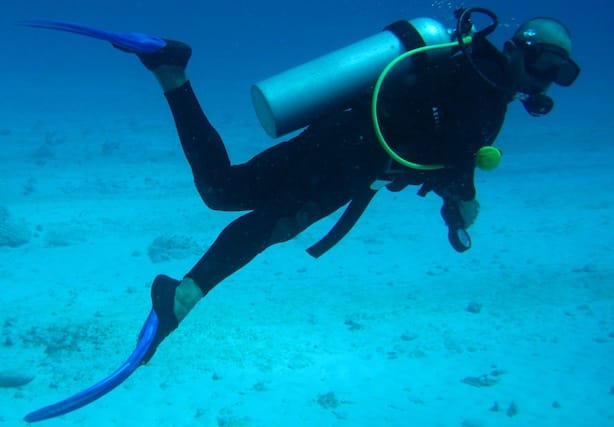

If you love exploring the ocean, chances are you’ve considered both scuba diving and surfing at some point. While these activities offer vastly different experiences, they share one essential piece of gear: the wetsuit. But can you use the same wetsuit for both? And what are the key differences between scuba diving vs surfing wetsuits?
This guide breaks down the characteristics of each wetsuit type and explains why choosing the right wetsuit is crucial—especially when diving in Coron to El Nido, home to some of the best diving Philippines has to offer.
Table of Contents
Understanding the Differences Between Scuba Diving vs Surfing Wetsuits
While both wetsuits provide thermal protection, they are designed for different environments, temperatures, and conditions.
1. Thickness & Thermal Protection
- Scuba Diving Wetsuits: Designed for full submersion, these wetsuits are thicker (typically 3mm to 7mm) to provide better insulation in cold water.
- Surfing Wetsuits: Made for surface activity, they are thinner and more flexible (2mm to 4mm) since surfers generate more body heat.
📍 Why It Matters in Coron to El Nido: Water temperatures in Palawan range from 26°C to 30°C (79°F to 86°F), so a 3mm wetsuit is ideal for diving while surfers may prefer a lighter 2mm suit.
2. Buoyancy & Compression Resistance
- Scuba Wetsuits: Designed to resist pressure at depth, preventing excessive compression that could reduce warmth and affect buoyancy.
- Surfing Wetsuits: Lighter and more flexible, but they compress significantly underwater, making them unsuitable for deep dives.
📍 In the Best Diving Philippines Locations: Scuba divers exploring Tubbataha Reefs or the wrecks of Coron need wetsuits that can handle deep-water pressure without losing insulation.
3. Mobility & Flexibility
- Surfing Wetsuits: Maximum stretch and flexibility to allow free movement for paddling and riding waves.
- Scuba Diving Wetsuits: More durable and dense, which can make movement slightly more restricted.
📍 Why It Matters: If you plan to surf in Siargao and then dive in Coron, you’ll need separate wetsuits suited to each activity.
4. Durability & Material Strength
- Scuba Wetsuits: Made from denser neoprene to withstand contact with BCD straps, weight belts, and dive gear.
- Surfing Wetsuits: Built for abrasion resistance, often reinforced around the knees and elbows to endure friction from the surfboard.
📍 Diving in Coron to El Nido: When navigating rocky entry points or using heavy dive equipment, a scuba-specific wetsuit will last longer.
Can You Use a Surfing Wetsuit for Scuba Diving?
Technically, yes—but it’s not recommended. Here’s why:
❌ Not thick enough for proper thermal protection.
❌ Lacks compression resistance, losing warmth at depth.
❌ Less durable and more likely to tear under diving gear.
💡 Best Alternative: If you only dive in warm, shallow waters, a thicker surfing wetsuit (3mm or more) might work, but a proper scuba wetsuit is the better choice.
Can You Use a Scuba Diving Wetsuit for Surfing?
Again, it’s possible—but not ideal:
❌ Too thick and restrictive, limiting movement for paddling.
❌ May cause overheating on the surface.
❌ Lacks knee and chest reinforcements for surfing durability.
📍 When It Works: If you surf occasionally and don’t mind the reduced flexibility, you can use a scuba wetsuit, but for long surf sessions, a dedicated surf wetsuit is best.
How to Choose the Right Wetsuit for Your Activity
1. Consider Water Temperature
- Tropical diving (26°C – 30°C / 79°F – 86°F): 3mm wetsuit (ideal for Coron, El Nido, Tubbataha).
- Colder waters (15°C – 25°C / 59°F – 77°F): 5mm to 7mm wetsuit.
- Warm-weather surfing: 2mm wetsuit or shorty wetsuit.
2. Look for the Right Features
✔ Scuba Divers: Prioritize compression resistance, durability, and seals for warmth.
✔ Surfers: Look for flexibility, lightweight materials, and reinforced knee/elbow pads.
3. Get the Right Fit
- A wetsuit should be snug but not too tight—it should allow movement without excessive water flow inside.
- Women’s wetsuits are designed for a better anatomical fit, so opt for gender-specific models when possible.
💡 Tip: Try wetsuits in-store at a PADI dive shop or surf store before purchasing.
FAQs
What is the main difference between a scuba and a surf wetsuit?
Scuba wetsuits are thicker, more durable, and designed for deep-water compression resistance, while surf wetsuits are lighter, more flexible, and ideal for surface activity.
Can I use one wetsuit for both scuba diving and surfing?
It’s not recommended, as scuba wetsuits are too restrictive for surfing and surf wetsuits lack the insulation and durability needed for diving.
What wetsuit thickness is best for Coron to El Nido diving?
A 3mm wetsuit is ideal for tropical diving conditions in the best diving Philippines locations.
How do I know if my wetsuit fits correctly?
It should be snug but comfortable, without restricting breathing or movement. The material should stretch slightly when wet.
Should I buy a wetsuit or rent one?
- Buy if you dive/surf frequently (for better fit and comfort).
- Rent if you only dive occasionally (cheaper and convenient for travel).
Conclusion
Choosing the right wetsuit can make or break your experience in the water. If you’re planning to dive the wrecks of Coron to El Nido or explore the best diving Philippines has to offer, investing in a proper scuba wetsuit will ensure warmth, safety, and durability.
While surfing wetsuits are designed for flexibility and movement, they lack the necessary thermal protection and compression resistance needed for scuba diving. To get the best of both worlds, it’s best to invest in separate wetsuits tailored to each activity.
Before purchasing, visit a PADI dive shop or surf retailer to find the perfect fit, ensuring comfort and efficiency in all your underwater adventures. 🌊🤿🏄♂️

